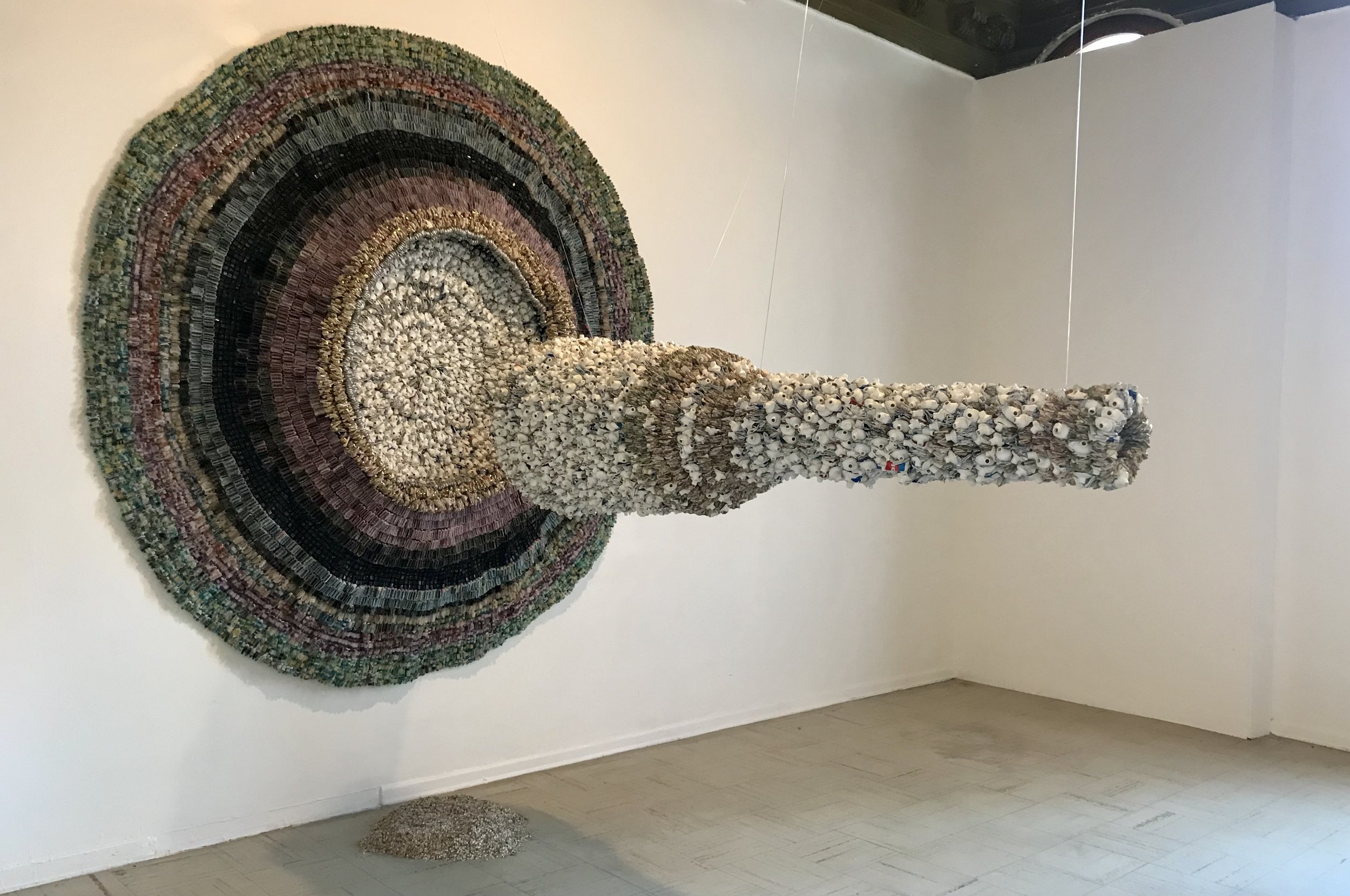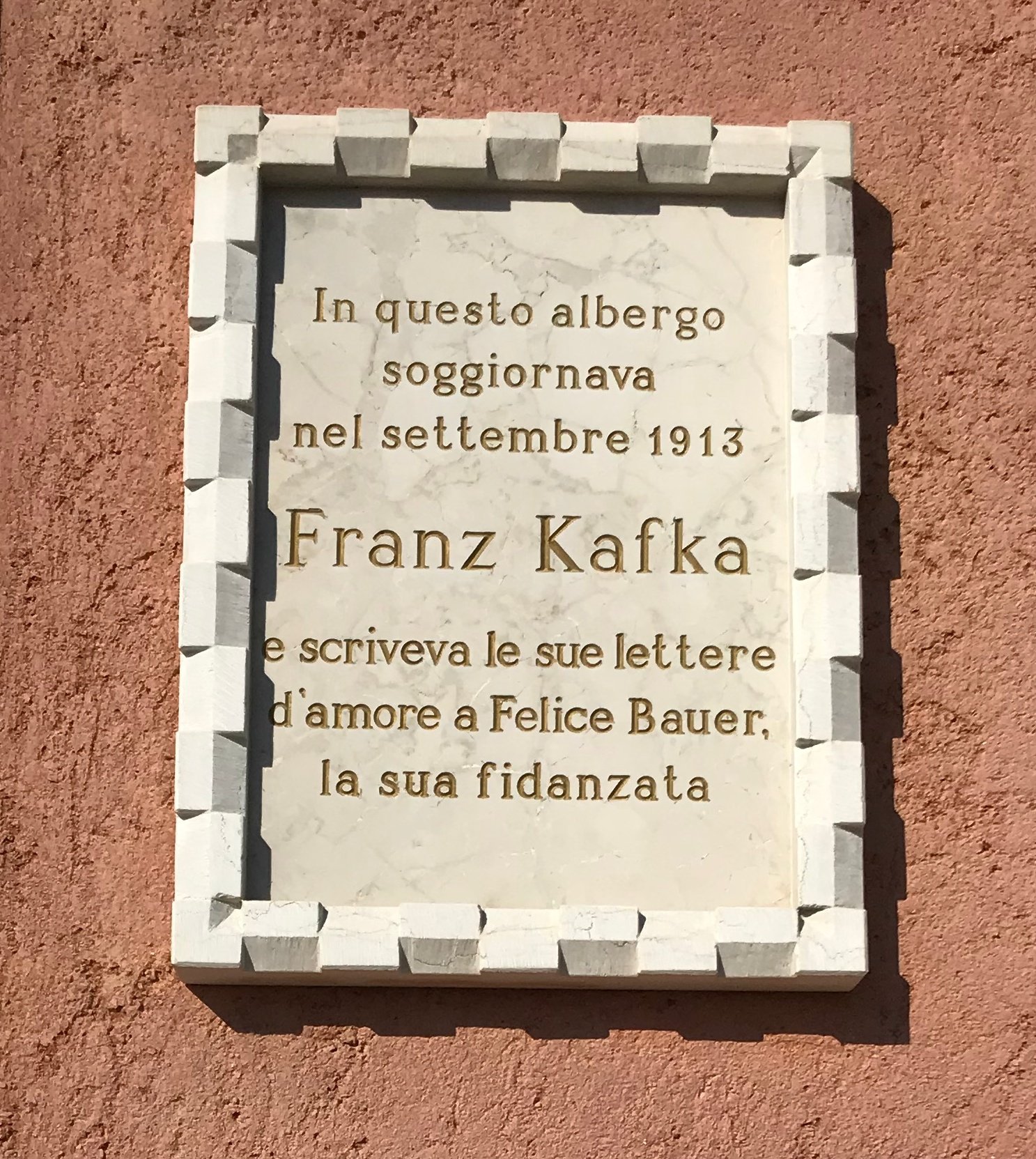Venice, via Rab
This post is not about Rab at all. It’s more an excuse to write about my first and long-awaited visit to the Venice Biennale, but as there are strong connections between Venice and Rab, I figured I could make it qualify as a ‘letter from Rab’.
What is the connection between Venice and Rab? It’s pretty significant. The influence of Venice is seen throughout on Rab from its city walls to its bell towers, ornamental windows, city grid, and general architecture. Rab was part of the tug of war that Venice played with other principalities (such as Dalmatia and Istria) on the coast. On-again, off-again, either directly or indirectly, Rab was part of Venice beginning in the mid-fourteenth century and officially became part of the Republic of Venice in 1409. It remained so until 1797, when a determined Frenchman showed up to claim Venice and its holdings—if only briefly—for his country.
Venetian mascots gracing a balcony in Rab’s Trg Municipium.
That, in short, is the direct connection between Venice and Rab, and, of course, Venice was connected with much of Croatia, not least of which because many of the millions of wood pilings that make it possible for Venice to exist at all as a city come from the forests of Croatia. And Istrian stone provided the foundation layer for many a Venetian building.
With that information in mind, I took off for Venice one morning, taking the catamaran to Rijeka then a bus to Venice. Prone as I am to motion sickness, the bus ride was just tolerable. But it was beautiful, too, passing through parts of Slovenia before dropping down to the coast at Trieste. I left Rab at 7am and was in the middle of Venice looking for my apartment by 2pm.
We were staying in the Santa Croce neighborhood—we being me, Anna (who lives in Australia), Andrea (who lives in the US), and Andrea’s husband, Michael. Anna, Andrea, and I spent one, wild year together in New Orleans at Tulane University many moons ago, then eventually fell out of touch as we all went in separate directions. Serendipity brought Anna and I back together about 15 years ago, and we both reconnected with Andrea this time last year. That’s the beauty of friendship: It stands the test of time and distance. We had all just been on Rab and now here we all were in Venice ready to take in as much art as we could in just over two days.
Our first stop was the Doge’s Palace, that sprawling landmark to the Venetian governmental and penal system, everything laid out in such a way to ensure that people entering the establishment knew their place at once. Each room is a feast for the eyes. Between the art here and in all of the churches in Venice, Venetian artists had no lack of wall space for their frescoes, paintings, sculptures, and friezes.
“Foreigner’s Everywhere,” by Claire Fontaine, the slogan and theme of 2024 Biennale.
After we wound our way through the palace, we headed down to the Arsenale, about a 30-minute walk. The farther from San Marco square, the fewer the crowds, a welcome change. The Venice Biennale is staged, largely, in two main venues: Arsenale and Giardini. Each venue has national pavilions showcasing (usually) one artist and also a mix of general exhibition spaces featuring many artists. Outside of these two venues, there are over a dozen national pavilions sprinkled around the city. Like the Doge’s Palace, it sprawls with art from over 300 artists (or artist collectives) and at least 69 countries taking over vast acreages.
The scale of the Biennale is truly astounding, beyond what I expected. The Arsenale itself, with its vaulted ceilings and red brick columns, gives one a feeling of grandness, of being in a temple. (The Arsenale was the former shipyard, building the warships that helped Venice become so dominant. How different would our world be if all military installations could be transformed into vast art venues that celebrate beauty?)
At the same time, many of the pieces draw you in and give the feeling of enfolding you, as was the case with the Takapau installation from the Mataaho Collective, four Māori women artists, which greets visitors at the entrance. A takapau, per the Biennale website, is “a finely woven mat, traditionally employed in ceremonies, particularly during childbirth.” Here, the weaving enshrouds the entire room, both the material of the mat itself and the reflections of it on the walls and floors. A profound, indescribable feeling to stand within this space.
The Mataaho Collective’s wondrous weaving.
There were several other works by collectives. Bordadoras de Isla Negra was a Chilean collective active between 1967 and 1980, and known for its textiles. On display here was an enormous embroidery with scenes from village life. Another artist grouping was the Disobedience Archive by Marco Scotini and featuring videos addressing gender politics, Arab dissent, and more, from dozens of artists. I could have spent several hours in the Disobedience Archive alone. One piece that held my attention was a video showing elderly Vietnamese—singly or in groups—singing “The International.” It was so poignant and raw. Their faces, to me, expressed all of the promise of their youthful years as well as the tragic reality of war.
Each room brought a fresh feeling of wonder and awe. I was particularly drawn to the textiles such as Dana Awartani’s Come, let me heal your wounds. Let me mend your broken bones and pieces that had a textile-like quality such as Naminapu Maymuru-White’s Milŋiyawuy and Greta Schodl’s Scritture series.
Naminapu Maymuru-White’s snakelike Milŋiyawuy.
For me, the most powerful installation in the Arsenale was from the Nicaraguan artist, Elyla, whose video performance, Torita-encuetada, was absolutely mesmerizing. The artist enacts a fire ritual, enveloping himself in ashes, embracing them, gaining strength from them. Anti-colonialism, sexual liberation, gender identity liberation—all displayed in this beautiful dance. Just stunning.
Elyla in Torita-encuetada.
And I cannot leave the Arsenale without mentioning another artist who turns the tables on colonialism and sexual identity: Peruvian Violeta Quispe. Her two pieces, Apu Suyos and El matrimonio de la chola rattle gender norms in a variety of ways, not least of which is to use as her medium a type of wood painting, Tablas de Sarhua, that was traditionally the domain of men. There is a playfulness to her work which intensifies the seriousness of her subject matter.
Day Two took us to the Giardini which was much more crowded than the Arsenale. It was a Saturday, perhaps that accounted for the larger crowds, or the fact that the Giardini has the lion’s share of the country pavilions and is considered the “main stage” for the Biennale.
By far the longest line was at the Australian pavilion for Archie Moore’s kith and kin which won the Golden Lion award for Best National Participation at the Biennale. It did not disappoint. Photos do no justice to the exhibit. You really must stand within it. Moore traces his own lineage over 2,400 generations on the black chalkboard walls of the room. The result looks less like a family tree and more like a mycorrhizal network—messy, ambiguous, and all interrelated. The interior of the room is a white diorama-type installation of redacted inquests of 557 Aboriginal people who have died in police and prison custody since 1991.
A very, small section of Archie Moore’s kith and kin.
I spent a lot of time in the national pavilions. Some were multisensory experiences such as Germany’s entry, Thresholds, a riot of sounds and images that explored destruction and rebirth with a bombed-out space juxtaposed with a futuristic, interplanetary voyage, among other things. ArtNews described it as “creepy, entrancing” both of which I think are fitting adjectives. Others were full-on riots of color such as the Jeffrey Gibson’s (United States) the space in which to place me in which the outside of the pavilion itself was painted in the bright colors and patterns that appear in his works. His sculptures—made from beads, buttons, jingles, and more—both demand and celebrate civil rights for all. Absolutely beautiful and evocative. And some pavilions featured photography such as Denmark’s Rise of the Sunken Sun with photos from Inuuteq Storch showing daily life in Greenland (Kalaallit Nunaat).
One of Jeffrey Gibson’s astonishingly beautiful sculptures.
Spain’s entry, Migrant Art Gallery, by Sandra Gamarra Heshiki was exceptional. Heshiki, who is Peruvian by birth and now lives in Spain, takes Old Masters’ paintings and reimagines them, fading the Europeans into the background and bringing the indigenous people to the forefront. She had a brilliant series in which indigenous portraits became the roots of botanical prints, emphasizing the origin of these plants over the Latin names given by Europeans.
Heshiki’s re-imagining of Old Masters’ paintings and botanical prints.
By now, I had been at the Giardini for over four hours and had visited many of the pavilions. It was getting late in the day and my friends had left, but I felt that I should at least go into the general exhibition hall and have a look inside. I am so glad that I did because there I stumbled upon the work of Aloïse, an artist unfamiliar to me who was active in the early 20th century and who spent 40 years of her life in a psychiatric hospital in Switzerland. Her vibrant and voluptuous portraits of women, some many feet long, are a treasure. For some reason, the paintings brought to mind Leonora Carrington’s novel, The Hearing Trumpet. Maybe the wild, surrealism of them all.
My new favorite surrealist—Aloïse.
After I left the Giardini, I wandered back toward the center of Venice, taking back streets and letting myself get lost in the process. And I’m very happy that I did. As I reached a dead end on one street, I walked into an open courtyard and realized that I had actually happened upon the Zimbabwe pavilion and its Undone installation. Several artists were on display. There was a strong sense of how humans impact the natural world and a questioning of what comes next such as in Moffat Takadiwa’s imposing collages incorporating thousands of discarded objects—notably, computer keys, plastic buttons, toothbrushes, etc.
One of Moffat Takadiwa’s works in the Zimbabwe pavilion.
I wandered from the Zimbabwe pavilion and went back toward the water. At one point, stopping to check for messages, I realized that I was standing beneath a plaque about Franz Kafka. What a nice surprise. To think that he had wandered these streets and penned love letters to Felice Bauer in this very spot—the spot being the Hotel Gabrielli.
That was enough to round out my day. I went in search of my friends and a glass of red wine.










